
NGC 4088 is an intermediate spiral galaxy in the constellation Ursa Major. The galaxy forms a physical pair with NGC 4085, which is located 11′ away.

The Atlas of Peculiar Galaxies is a catalog of peculiar galaxies produced by Halton Arp in 1966. A total of 338 galaxies are presented in the atlas, which was originally published in 1966 by the California Institute of Technology. The primary goal of the catalog was to present photographs of examples of the different kinds of peculiar structures found among galaxies.

Arp 87 is a pair of interacting galaxies, NGC 3808A and NGC 3808B. They are situated in the Leo constellation. NGC 3808A, the brighter, is a peculiar spiral galaxy, while NGC 3808B is an irregular galaxy.

NGC 383 is a double radio galaxy with a quasar-like appearance located in the constellation Pisces. It is listed in Halton C. Arp's 1966 "The Arp Atlas of Peculiar Galaxies." Recent discoveries by the National Radio Astronomy Observatory in 2006 reveal that NGC 383 is being bisected by high energy relativistic jets traveling at relatively high fractions of the speed of light. The relativistic electrons in the jets are detected as synchrotron radiation in the x-ray and radio wavelengths. The focus of this intense energy is the galactic center of NGC 383. The relativistic electron jets detected as synchrotron radiation extend for several thousand parsecs and then appear to dissipate at the ends in the form of streamers or filaments.

NGC 2608 is a barred spiral galaxy located 93 million light-years away in the constellation Cancer. It is 62,000 light-years across, and about 60% of the width of the Milky Way. It is considered a grand design spiral galaxy and is classified as SB(s)b, meaning that the galaxy's arms wind moderately around the prominent central bar.

NGC 3432 is an edge-on spiral galaxy that can be found in the northern constellation of Leo Minor. It was discovered by German-British astronomer William Herschel on March 19, 1787. This galaxy is located at a distance of 40 million light-years (12.3 Mpc) from the Milky Way. It is interacting with UGC 5983, a nearby dwarf galaxy, and features tidal filaments and intense star formation. Because of these features, it was listed in Halton Arp's Atlas of Peculiar Galaxies.
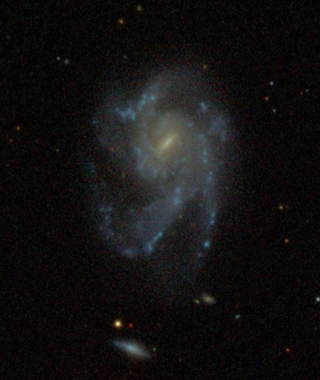
NGC 5579 is an intermediate spiral galaxy in the northern constellation of Boötes. It was discovered on May 1, 1785) by German-British astronomer William Herschel. The galaxy is located at a distance of 179 ± 14 million light-years (54.9 ± 4.3 Mpc) from the Milky Way, and is receding with a heliocentric radial velocity of 3,608 km/s. It is entry 69 in Halton Arp's Atlas of Peculiar Galaxies.

NGC 1023 is a barred lenticular galaxy, a member of the NGC 1023 group of galaxies in the Local Supercluster. Distance measurements vary from 9.3 to 19.7 million parsecs (30 to 64 million light-years). The supermassive black hole at the core has a mass of (4.4±0.5)×107 M☉. The black hole was discovered by analyzing the dynamics of the galaxy.

Arp 273 is a pair of interacting galaxies, 300 million light years away in the constellation Andromeda. It was first described in the Atlas of Peculiar Galaxies, compiled by Halton Arp in 1966. The larger of the spiral galaxies, known as UGC 1810, is about five times more massive than the smaller galaxy. It has a disc that is tidally distorted into a rose-like shape by the gravitational pull of the companion galaxy below it, known as UGC 1813. The smaller galaxy shows distinct signs of active star formation at its nucleus, and "it is thought that the smaller galaxy has actually passed through the larger one."

NGC 5566 is a barred spiral galaxy in the constellation Virgo, which is approximately 66 million light years away from Earth. The galaxy is the biggest in the constellation Virgo, stretching nearly 150,000 light years in diameter. The galaxy NGC 5566 was discovered on 30 April 1786 by the German-British astronomer William Herschel. It is included in Halton Arp's Atlas of Peculiar Galaxies. It is a member of the NGC 5566 Group of galaxies, itself one of the Virgo III Groups strung out to the east of the Virgo Supercluster of galaxies.

Arp 7 is a spiral galaxy in the constellation Hydra. Redshift-independent measurements of its distance vary widely, from 5.9 Mpc to 83.7 Mpc. Its morphological classification is SB(rs)bc, meaning it is a barred spiral galaxy with some ring-like structure.

NGC 2857 is a spiral galaxy in the constellation Ursa Major. It was discovered on January 9, 1856, by R. J. Mitchell.

NGC 169 is a barred spiral galaxy located in the constellation Andromeda. It was discovered on September 18, 1857 by R. J. Mitchell.

NGC 191 is a spiral galaxy located in the constellation Cetus. It was discovered on November 28, 1785, by William Herschel.
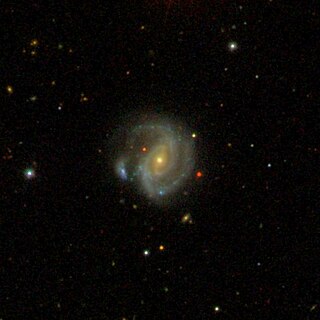
NGC 341 is a spiral galaxy in the constellation Cetus. It was discovered on October 21, 1881 by Édouard Stephan. It was described by Dreyer as "faint, pretty large, round, a little brighter middle, mottled but not resolved." It has a companion galaxy, PGC 3627, which is sometimes called NGC 341B. For this, reason, it has been included in Halton Arp's Atlas of Peculiar Galaxies.
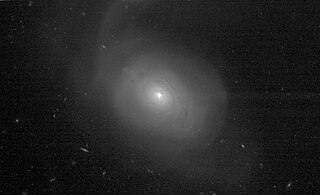
NGC 7603 is a spiral Seyfert galaxy in the constellation Pisces. It is listed in the Atlas of Peculiar Galaxies. It is interacting with the smaller elliptical galaxy PGC 71041 nearby.

NGC 497 is a barred spiral galaxy approximately 336 million light-years away from Earth in the constellation of Cetus. It was discovered by French astronomer Édouard Stephan on November 6, 1882.
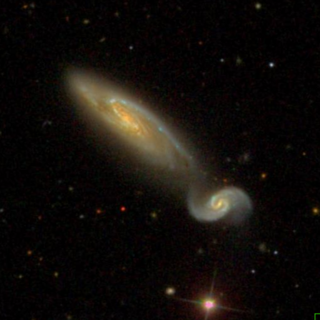
NGC 3800 is an intermediate spiral galaxy located in the constellation Leo. Its speed relative to the cosmic microwave background is 3,653 ± 24 km/s, which corresponds to a Hubble distance of 53.9 ± 3.8 Mpc. NGC 3800 was discovered by German-British astronomer William Herschel in 1784.

NGC 3799 is a barred spiral galaxy located in the constellation Leo. Its speed relative to the cosmic microwave background is 3,659 ± 24 km/s, which corresponds to a Hubble distance of 54.0 ± 3.8 Mpc. NGC 3799 was discovered by British astronomer John Herschel in 1832.
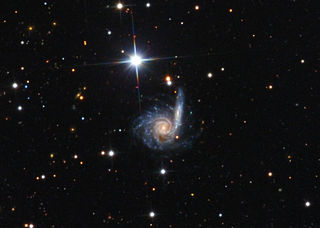
NGC 6365 is a pair of spiral galaxies in the constellation Draco. It consists of two galaxies, PGC 60174 to the south, and PGC 60171 to the north. These two galaxies are also designated respectively by the NASA/IPAC database as NGC 6365A and NGC 6365B. This pair of galaxies was discovered by German astronomer Lewis Swift in 1884.




















